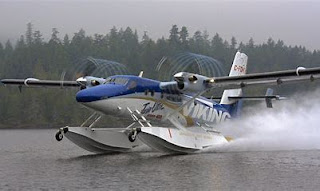Aircrafts can be classified into various types depending on the mode of classification like no. of powerplants, position of wing, speed, tail configuration, size, Utility (Military, Civil), etc. Broadly they can be classified at air as a parameter which gives
1. Lighter than Air Aircraft (also known as Aerostats)
2. Heavier than air Aircraft (also known as Aerodynes)
Lighter than Air
Any aircraft kept skywards by a gas, lighter than air contained by the craft is known as an aerostat.
Examples of Aerostat are:-
 |
| Airships |
 |
| Kite Balloons |
Heavier than Air
Aerodyne is the name for all heavier than air aircrafts. Basically, all the aircrafts, which derive lift from aerodynamic forces falls into this category. Further classified on the basis of power supply.
Non-Engine Driven
These aircrafts do not have a power supply and only uses aerodynamic forces to be airborne for longer
endurance.
 |
Kites
|
 |
| Gliders or Sailplanes |
Engine Driven
Alongside with aerodynamic forces, these aircrafts are aided with engines or powerplants for sustaining flight. Based on the lift producing surface, these are categorized as:-
1. Airplane
These are the fixed wing span aircraft where power is provided by engine around the fuselage. As per their taking off mechanism these are named as-
Land Plane
The airplane with landing gears which can takeoff from runway only.
Sea Plane
Airplanes with ability to take off or land on sea only. Having floating pads instead of landing gears (Float Plane) or hull like boat for buoyancy (Flying boat).
 |
| Flying Boat |
 |
| Float Plane |
Amphibian
Airplane with aptness to takeoff and land on both land and sea.
2. Rotary Wing Aircrafts
Machines that produce lift by rotating wings or propellers which are further tabulated on the premise of orientation and position of rotating wings as:-
Helicopters
A helicopter is a rotorcraft in which lift and thrust are supplied by horizontally spinning rotors which features it for vertical takeoff and landing or to hover at a particular point in space. Depending upon the configuration of rotors, these are sorted as follows :-
 |
| Tandem Rotor |
 |
| Single Main Rotor with Tail rotor |
 |
| Side-by-side Non-Intermeshing Rotor |
 |
| Coaxial Rotor |
 |
| Side-by-side Intermeshing Rotor |
Gyroplane
Also known as autogyro is a type of aircraft which uses an unpowered rotor in free rotation to produce lift and forward thrust by a separate engine driven propeller.
3. Ornithopter
An aircraft that flies by flapping its wings. Designed to imitate the flapping wing flight of birds.



















👍👍👍
ReplyDeleteCool 👍👍
ReplyDeleteVery informative
ReplyDelete👌👌👌👍👍👍👍👍
ReplyDelete